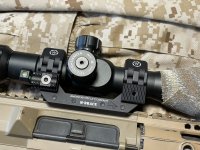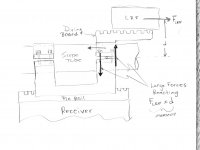Awesome. Look forward to new products. Loving the mount so far!More accessories are in work. These include HUD, ACI, and RMR type mounts. SendIt is already good to go using Pic rail.
Join the Hide community
Get access to live stream, lessons, the post exchange, and chat with other snipers.
Register
Download Gravity Ballistics
Get help to accurately calculate and scope your sniper rifle using real shooting data.

Install the app
How to install the app on iOS
Follow along with the video below to see how to install our site as a web app on your home screen.
Note: This feature may not be available in some browsers.
You are using an out of date browser. It may not display this or other websites correctly.
You should upgrade or use an alternative browser.
You should upgrade or use an alternative browser.
New M-BRACE Scope Mount $279 from American Rifle Company
- Thread starter karagias
- Start date
Will the RMR mount be offset-45, or top mount?
My mount comes in tomorrow. Really looking forward to it. Thanks for the quick shipping!
My mount comes in tomorrow. Really looking forward to it. Thanks for the quick shipping!
Good question, I bet they will offer both eventually.Will the RMR mount be offset-45, or top mount?
My mount comes in tomorrow. Really looking forward to it. Thanks for the quick shipping!
Maybe a carry handle while we're at it?
Well it's kinda funny, and I'm kinda serious.
Was in the shop with the rifle on the bench after mounting and zeroing it. Grabbed it by the scope to move it. Thought.. hmmm would be nice if a A2 handle would mount to the M Brace.
Not practical, and probably not recommend to lift a 16 lbs rifle by the scope and mount.
Then again I'm not practical
Was in the shop with the rifle on the bench after mounting and zeroing it. Grabbed it by the scope to move it. Thought.. hmmm would be nice if a A2 handle would mount to the M Brace.
Not practical, and probably not recommend to lift a 16 lbs rifle by the scope and mount.
Then again I'm not practical
Speaking professionally as an engineer: if lifting the rifle - any man-portable rifle - by a modern scope were a problem, your system has much worse problems, like not being able to reliably hit a dinner plate at 50yd*. Now, with the scope right up tight against the action finger access for a good grip might be troublesome, but that’s an ergo issue not a mechanics problem. I’d be more worried about damaging the bore from a weird drop onto gravel.Well it's kinda funny, and I'm kinda serious.
Was in the shop with the rifle on the bench after mounting and zeroing it. Grabbed it by the scope to move it. Thought.. hmmm would be nice if a A2 handle would mount to the M Brace.
Not practical, and probably not recommend to lift a 16 lbs rifle by the scope and mount.
Then again I'm not practical
* I was getting minimum numbers of a few thousand pounds before any interface or component failed.
Good to know. No, it's all solid components so I'm not worried. And with the blessing of an engineer, even better.Speaking professionally as an engineer: if lifting the rifle - any man-portable rifle - by a modern scope were a problem, your system has much worse problems, like not being able to reliably hit a dinner plate at 50yd*. Now, with the scope right up tight against the action finger access for a good grip might be troublesome, but that’s an ergo issue not a mechanics problem. I’d be more worried about damaging the bore from a weird drop onto gravel.
* I was getting minimum numbers of a few thousand pounds before any interface or component failed.
Okay Ted, we want a carry handle that mounts to the M Brace. Please.
Interested in this as well. I’m wanting to try mounting a rmr for target acquisition purposes and haven’t found a lot of options at the moment. I do love my M10 rings so if these do pop off ill probably be forced to place an orderWill the RMR mount be offset-45, or top mount?
My mount comes in tomorrow. Really looking forward to it. Thanks for the quick shipping!
What am I missing? Calibrate the level?Is there any way to calibrate the level?
1. Connect the mount to your rifle's Pic rail. Snug the Pic rail clamp screws.
2. Place your scope into the mount. Leave the scope clamp screws loose enough so that you can easily roll the scope in the rings.
3. Locate a vertical reference in the distance, such as a plumb line, and point your rifle at it.
4. Roll the rifle until the level on the mount indicates level.
5. Carefully roll the scope in the rings until the vertical crosshair is parallel with the vertical reference (plumb line).
6. Repeat steps 4 and 5 until you're satisfied.
7. Tighten the scope clamp screws to lock your scope in place making damn sure to notice that your scope didn't roll in the rings when doing so, thereby exemplifying the awesomeness American Rifle Company's scope ring design.
8. Torque all screws to about 55 pound-inches.
Now, one might say, "I want the level on my mount to agree with a level I placed on my rifle because the internet told me I should want this." Well, the level on your mount will likely achieve this but if it doesn't, you're going to have to use a scope-tube mounted level or some other adjustable level. That said, I'm not sure how such a requirement can possibly be relevant considering the fact that a bullet's trajectory through the earth's atmosphere is three-dimensional. So long as the vertical crosshair is parallel to gravity when the level indicates level, you're good to go, regardless of the orientation of the rifle with respect to the level.
I hope that helps.
Ted
A carry-handle is a great idea but it must be fashioned from wood and steel, and when using said wooden-ferrous handle to carry your rifle while running, you must be wearing a pith helmet, as if working hard to colonize a culturally inferior population, the technology of whom is no match for that which you bring to bear. A pipe is optional but strongly encouraged. Cigars are also OK.Good to know. No, it's all solid components so I'm not worried. And with the blessing of an engineer, even better.
Okay Ted, we want a carry handle that mounts to the M Brace. Please.
Ted
Oh man, my rifle definitely NEEDS one of these FAL handles!! 



On a serious note, the M-BRACE is a nice mount, I had been looking for something to clamp my AMG without obscuring the parallax knob too much, AND, I got an extra 10moa to build in. Nice design Ted.

On a serious note, the M-BRACE is a nice mount, I had been looking for something to clamp my AMG without obscuring the parallax knob too much, AND, I got an extra 10moa to build in. Nice design Ted.
Any plans to make a lower M-Brace? Something around 24-28mm? I have 4 of the 32mm high mounts, but would like if a couple of them were a tad lower.More accessories are in work. These include HUD, ACI, and RMR type mounts. SendIt is already good to go using Pic rail.
Or if the brace just mounts to the rifle. I.E. rem 700 actions would be niceAny plans to make a lower M-Brace? Something around 24-28mm? I have 4 of the 32mm high mounts, but would like if a couple of them were a tad lower.
Please pardon my ignorance, why would I run this over a Badger (5 oz) and diving board (3 oz I believe)?
By the time the LRF mount is installed the total weight is almost 15 oz. Speak to me like a child because I haven't gone down the ring mount rabbit hold (yet) as I use mostly gas guns but am starting to branch out. Thanks
By the time the LRF mount is installed the total weight is almost 15 oz. Speak to me like a child because I haven't gone down the ring mount rabbit hold (yet) as I use mostly gas guns but am starting to branch out. Thanks
Check out post #38 in this threadPlease pardon my ignorance, why would I run this over a Badger (5 oz) and diving board (3 oz I believe)?
By the time the LRF mount is installed the total weight is almost 15 oz. Speak to me like a child because I haven't gone down the ring mount rabbit hold (yet) as I use mostly gas guns but am starting to branch out. Thanks
Let me chime in on this as well. For a gas gun that needs the extra, extended "reach" for eye relief, and you don't want to run face smashed in the stock, then BO or Scalarworks is your best bet. You can run 1.70" or 1.93" for a more relaxed shooting position. Trust me, I love them both and still run a BO 1.93" on one of my rigs. But.. the ARC is KING for built like a tank units. It's got the best in the business ring clamp system, and gives you a boatload of Accessory mount points too. Yes, it's heavy. More in line for use on guns that are already heavy and don't mind the additional weight. I just installed one on my .22LR bench rig. I've already got an 18" Kidd 3lb barrel, and a Razor Gen II 4.5-27 3lb scope.. so who cares.Please pardon my ignorance, why would I run this over a Badger (5 oz) and diving board (3 oz I believe)?
By the time the LRF mount is installed the total weight is almost 15 oz. Speak to me like a child because I haven't gone down the ring mount rabbit hold (yet) as I use mostly gas guns but am starting to branch out. Thanks
Plus the fact the ARC comes with a nice bubble level, and is priced right. There's no doubt in my mind I made the right choice for this setup. Pics to follow.
Edit: And let me weigh my BO mount. The scope is out for repair, and I can give you an accurate weight for a 1.93" 0 MOA unit..
My Badger mount mentioned above weighs 6.91 oz
Last edited:
Not the best pics, but here's my M-Brace'd .22LR beast..
Edit: Also, I was really leery of torquing down the ring clamps to 55 in/lb yesterday. I called Vortex and validated we're GTG at that figure. The last thing I wanted to do is crush a $2k scope tube. Not that Ted doesn't know what he's talking about.. I just HAD to be sure.
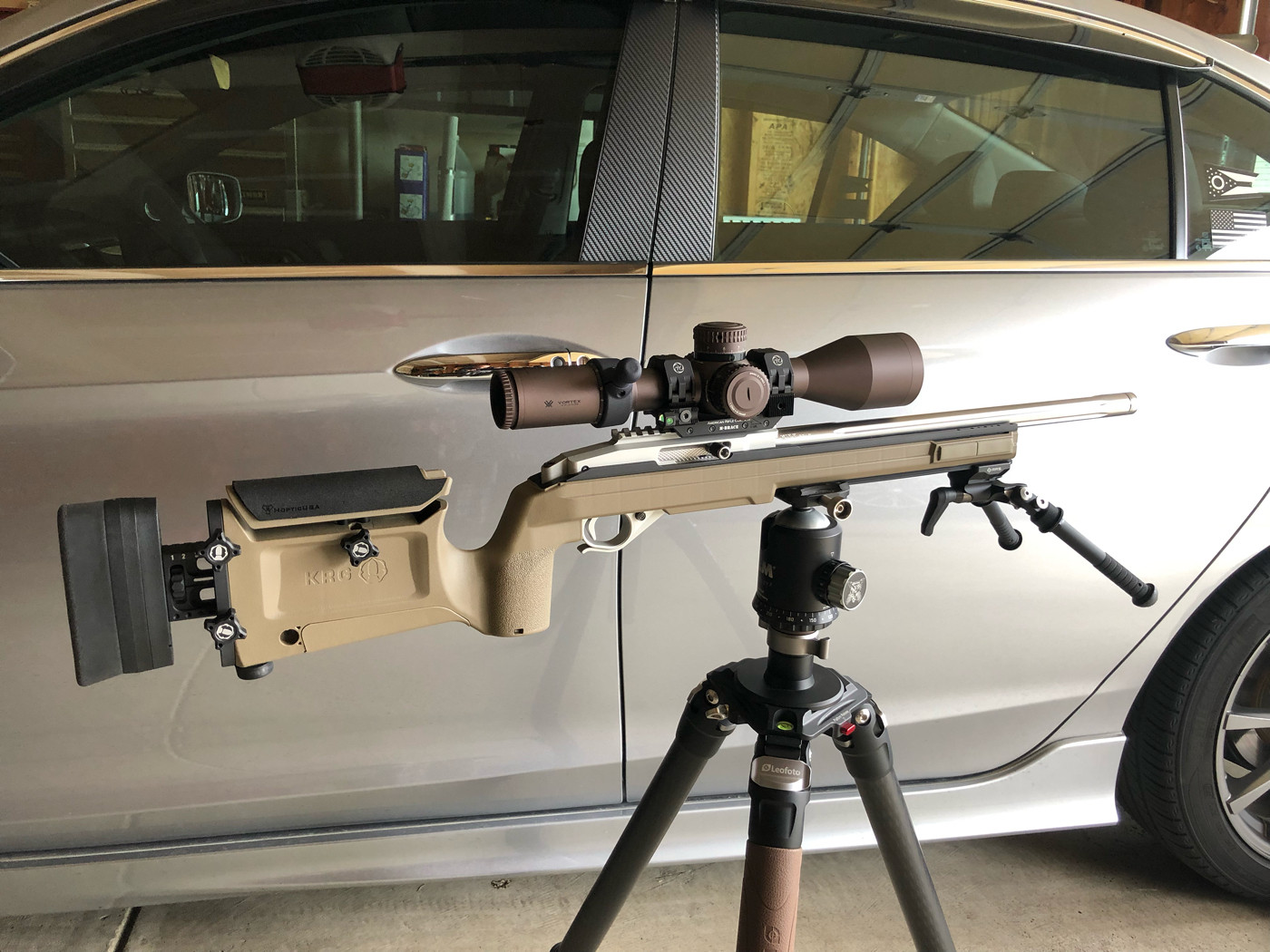
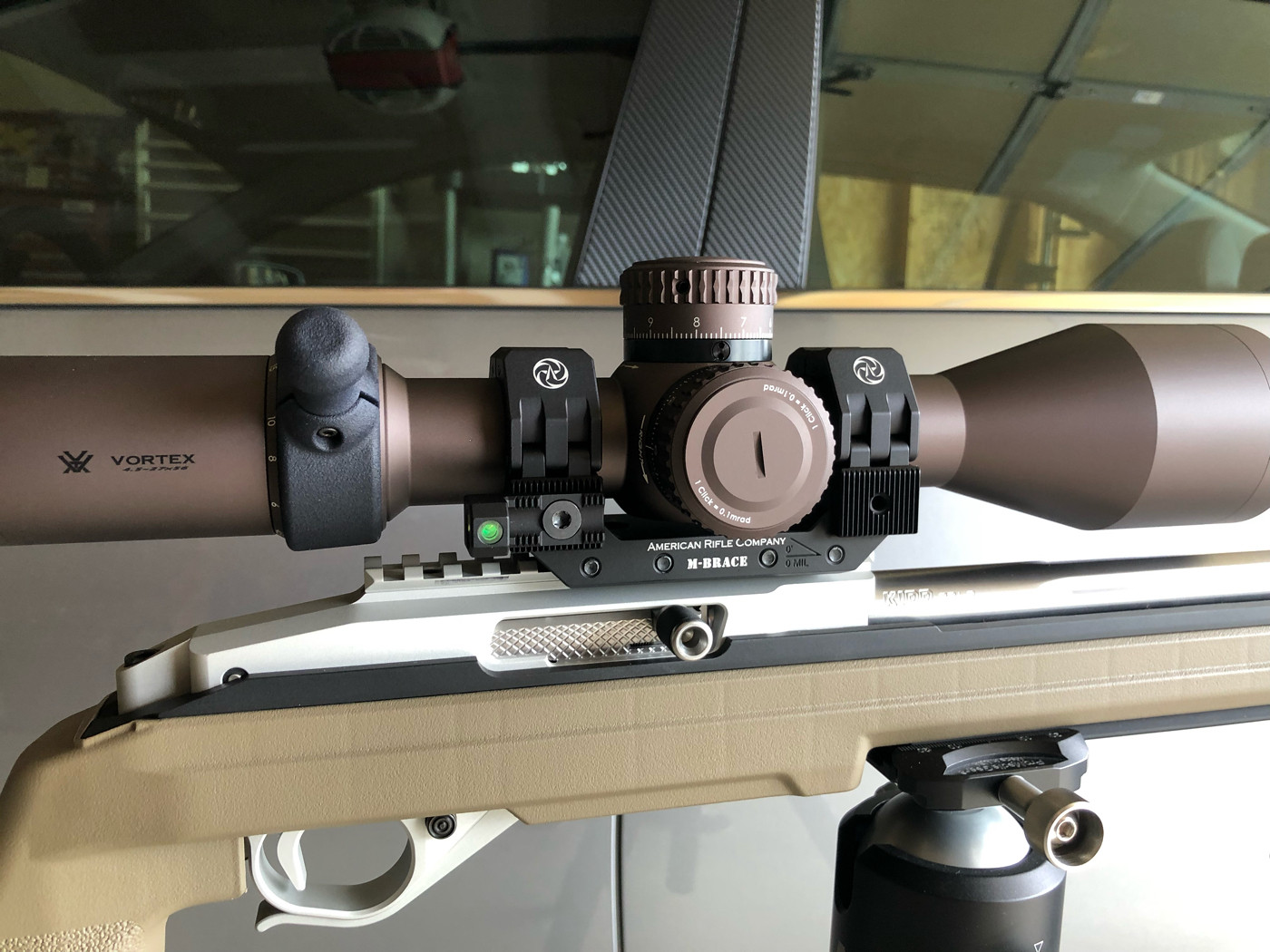
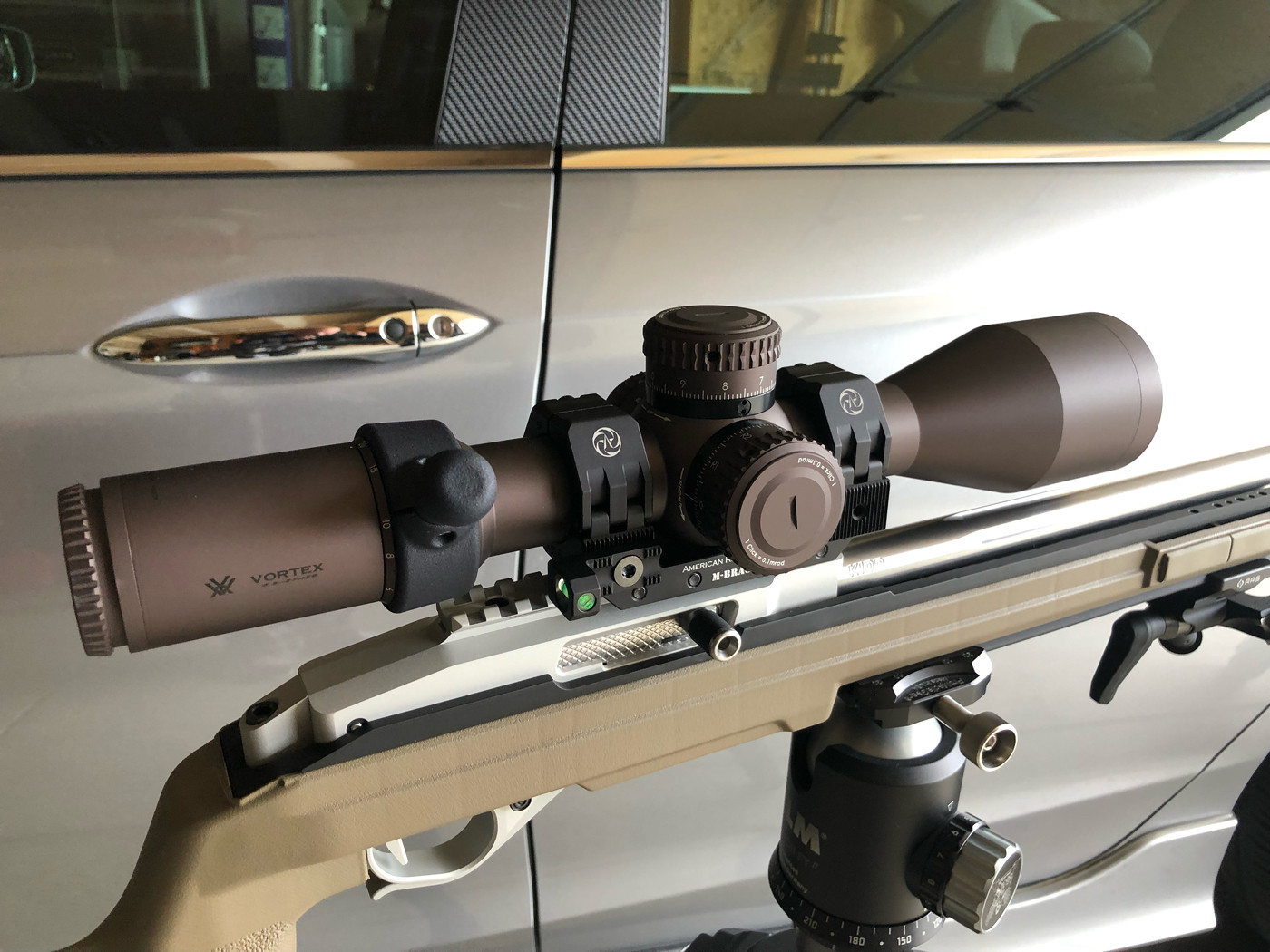
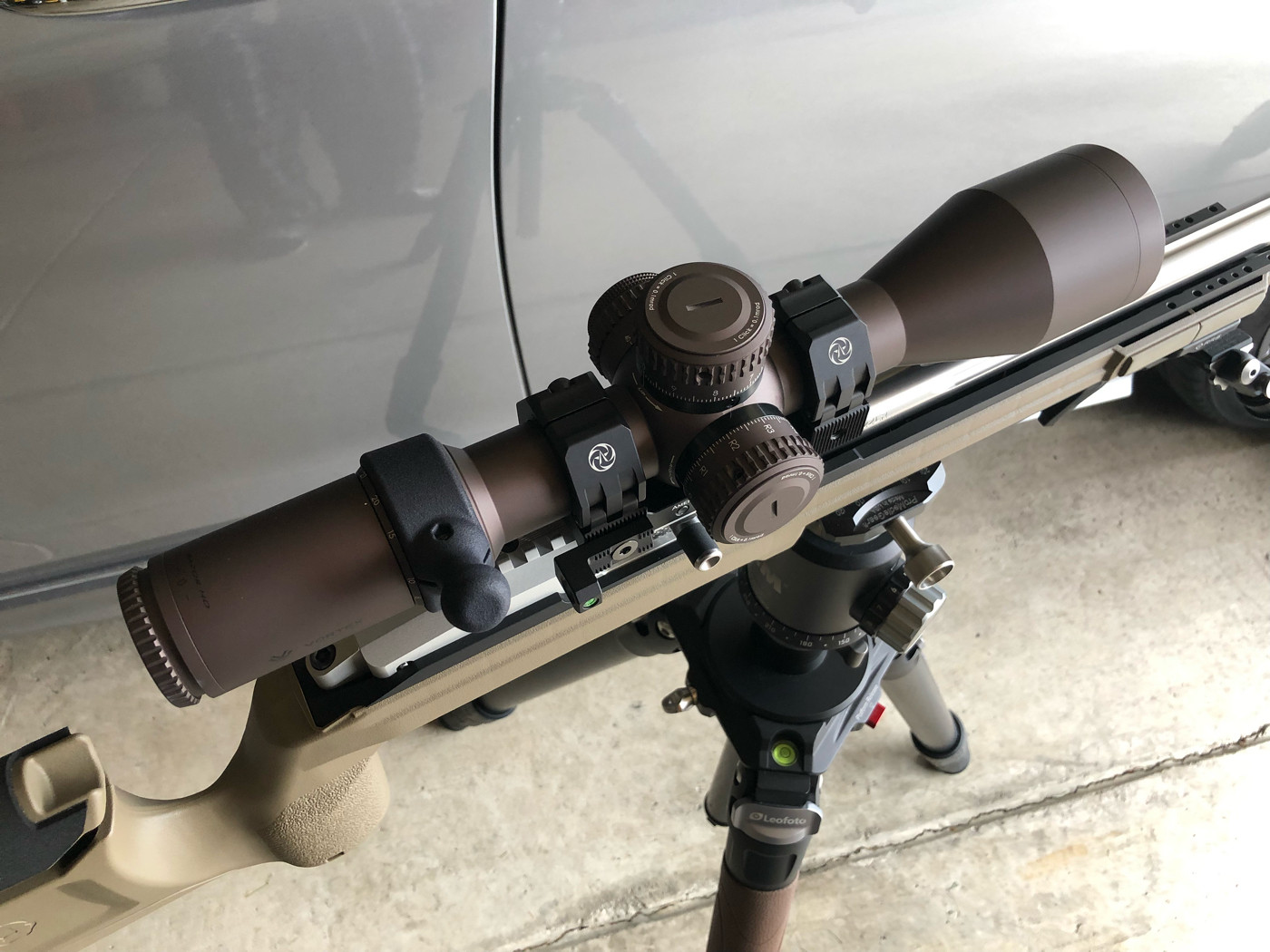
Edit: Also, I was really leery of torquing down the ring clamps to 55 in/lb yesterday. I called Vortex and validated we're GTG at that figure. The last thing I wanted to do is crush a $2k scope tube. Not that Ted doesn't know what he's talking about.. I just HAD to be sure.




Last edited:
Neither did I.Damn. I didnt think I'd find something to take me away from my m10 rings. I've got like 4 sets of them.
Attachments
Fantastic question and thanks for asking it and for welcoming a response.Please pardon my ignorance, why would I run this over a Badger (5 oz) and diving board (3 oz I believe)?
By the time the LRF mount is installed the total weight is almost 15 oz. Speak to me like a child because I haven't gone down the ring mount rabbit hold (yet) as I use mostly gas guns but am starting to branch out. Thanks
Short answer: Because the M-BRACE + LRF is not a diving board.
Long answer:
Firstly, many in the precision bolt gun world don't care about weight. More weight results in less movement during recoil thus enabling shooters to see the trace of the bullet as it flies through the air and the impact (or miss) of the bullet on target. Sit behind a shooter and watch his target with a spotting scope. The trace will appear as an atmospheric disturbance heading towards the target, kind of like the special effect behind the bullets in the Matrix movie. Bullets get to the target quickly so if you're knocked off of the gun by recoil, you'll miss the trace. Hense, weight is good for precision-long-range shooting.
Secondly, the mount was designed for use with LRF (laser range finder) devices. These can be heavy, weighing about a pound, and due to their placement, usually above the scope, the forces imparted by the LRF mount upon the scope mount can be very high, especially for big guns like 338 Lapua Mags on up. The M-BRACE is designed to ACTUALLY handle such forces while maintaining the positional relationship between the scope and the LFR. That's hard, if not impossible to do without a weight penalty.
Attaching a diving board to a scope ring cap is, as I like to say, a Micky Mouse solution. Only a non-engineer would offer such a thing. Mechanical engineers don't ignore forces acting on parts under consideration, at least not intentionally anyway. It's also worth noting that there is more to engineering that just running a CAD system. With experience, actual engineers can shape parts with a seemingly innate ability to anticipate the stress state in a part under load. The magnitude of the stress is unknown to them until calculations or computer analysis is done, but they can often (not always) predict where stress will be concentrated. It is with stress in mind that actual engineers design parts. We knew the M-BRACE mount would have to carry a moment (force applied from a distance, kind of like torque) which naturally focused our attention on the connection between the scope mount and the LRF mount. Serrations can bear such loads efficiently, thus their inclusion within the system.
All that said, .223 gas guns have light recoil and diving boards might be OK. Nevertheless, I think it's wise to avoid something that's colloquially referred to as a "diving board" and that's intended to be a structural component.
M-BRACE + LFR is not a diving board. That's why you ought to choose it. I think we're (ARC) might be the first one's to actually solve this problem correctly.
Thanks again for the question.
Ted
M10 rings are part of M-BRACE. They share almost all of their DNA.Neither did I.
You guys are keeping me busy.Not the best pics, but here's my M-Brace'd .22LR beast..
Edit: Also, I was really leery of torquing down the ring clamps to 55 in/lb yesterday. I called Vortex and validated we're GTG at that figure. The last thing I wanted to do is crush a $2k scope tube. Not that Ted doesn't know what he's talking about.. I just HAD to be sure.




Regarding 55 inch-pound torque for scope ring clamp screws.
Our M10 Rings and M-BRACE mount both use a single M5 x 0.8 screw for each scope ring. In order to get approximately the same amount of screw tension (scope clamping force needed to resist recoil) as one would get by applying about 15-20 in-lbs of torque to two smaller screws commonly used on other rings and mounts, 55 in-lbs is must be applied to the M5 screws that we use. Big screws can ultimately carry higher loads, as our single M5 carries about the same load as two smaller screws, but more torque must be applied to do so.
But in the case of your 10/22 (which looks sweet by they way) 55 in-lbs is not required. You'd likely be fine at 30.
How tight should the screws be? Ideally just tight enough to immobilize the scope against recoil forces. How tight is that? It depends on the weight of the scope, the wall thickness of the scope tube, the weight of the rifle, the bore diameter, max chamber pressure, mass moment of inertia of the entire weapon system, etc...
You get the idea. 55 in-lbs is the easy answer.
Oh, and I know, when referring to screw torque, it's proper to express torque as pound-inches instead of inch-pounds. But I like saying inch-pounds, just because. I really like saying Newton-meters because using pounds and inches is really stupid, but such is the world as I find it.
Ted
Man, that a bunch more part numbers...Or if the brace just mounts to the rifle. I.E. rem 700 actions would be nice
Ted
Not at this time. A 30mm diameter x 28mm height might be OK. We need to make sure that the underside of the scope turrets don't interfere with the bridge connecting the rings. 34 x 28 would likely be a no go, especially with S&B scopes. We'll look into a 30 x 28 but that might not play well with the serrations.Any plans to make a lower M-Brace? Something around 24-28mm? I have 4 of the 32mm high mounts, but would like if a couple of them were a tad lower.
We've also considered a serration-less M-BRACE, just two connected rings without provisions for accessories. It would be a bit lighter and lots of folks don't run accessories.
What kind of scope are your running.
Ted
Those are exactly the handles I had in mind. I've always wants a FAL but I've never got around to getting one. Should have bought'em up back in the 80's. I knew back then that they'd be worth having but I was just a poor teenager at the time. I might try to talk a friend out of his Belgian 50.00.Oh man, my rifle definitely NEEDS one of these FAL handles!!

View attachment 7716521
On a serious note, the M-BRACE is a nice mount, I had been looking for something to clamp my AMG without obscuring the parallax knob too much, AND, I got an extra 10moa to build in. Nice design Ted.
View attachment 7716523
Thanks for the business, the pic, and the compliment. Enjoy the mount...
Ted
So the thought is something stiffer than the QD-L, but otherwise broadly comparable?We've also considered a serration-less M-BRACE, just two connected rings without provisions for accessories. It would be a bit lighter and lots of folks don't run accessories.
Got my mount and love it. I did however find out that the parallax wheel on the kahles DLR will not work with this mount. So just be aware if you have that scope and plan on using this mount. I ended up just moving the kahles to a set of m10 rings I already had, and the scope that was in those rings into the mount.
Fantastic question and thanks for asking it and for welcoming a response.
Short answer: Because the M-BRACE + LRF is not a diving board.
Long answer:
Firstly, many in the precision bolt gun world don't care about weight. More weight results in less movement during recoil thus enabling shooters to see the trace of the bullet as it flies through the air and the impact (or miss) of the bullet on target. Sit behind a shooter and watch his target with a spotting scope. The trace will appear as an atmospheric disturbance heading towards the target, kind of like the special effect behind the bullets in the Matrix movie. Bullets get to the target quickly so if you're knocked off of the gun by recoil, you'll miss the trace. Hense, weight is good for precision-long-range shooting.
Secondly, the mount was designed for use with LRF (laser range finder) devices. These can be heavy, weighing about a pound, and due to their placement, usually above the scope, the forces imparted by the LRF mount upon the scope mount can be very high, especially for big guns like 338 Lapua Mags on up. The M-BRACE is designed to ACTUALLY handle such forces while maintaining the positional relationship between the scope and the LFR. That's hard, if not impossible to do without a weight penalty.
Attaching a diving board to a scope ring cap is, as I like to say, a Micky Mouse solution. Only a non-engineer would offer such a thing. Mechanical engineers don't ignore forces acting on parts under consideration, at least not intentionally anyway. It's also worth noting that there is more to engineering that just running a CAD system. With experience, actual engineers can shape parts with a seemingly innate ability to anticipate the stress state in a part under load. The magnitude of the stress is unknown to them until calculations or computer analysis is done, but they can often (not always) predict where stress will be concentrated. It is with stress in mind that actual engineers design parts. We knew the M-BRACE mount would have to carry a moment (force applied from a distance, kind of like torque) which naturally focused our attention on the connection between the scope mount and the LRF mount. Serrations can bear such loads efficiently, thus their inclusion within the system.
All that said, .223 gas guns have light recoil and diving boards might be OK. Nevertheless, I think it's wise to avoid something that's colloquially referred to as a "diving board" and that's intended to be a structural component.
M-BRACE + LFR is not a diving board. That's why you ought to choose it. I think we're (ARC) might be the first one's to actually solve this problem correctly.
Thanks again for the question.
Ted
I really appreciate the in depth and honest response Ted, that’s exactly what I was hoping to learn. Anything that puts less stress on the LRF / scope tube and directs that to the receiver is a great thing and is probably worth the weight. Just getting the weight of the LRF back to the scope and off the forend is smart weight distribution.
After having some time to think about this, I realize I could have done a better job with the answer to your question.I really appreciate the in depth and honest response Ted, that’s exactly what I was hoping to learn. Anything that puts less stress on the LRF / scope tube and directs that to the receiver is a great thing and is probably worth the weight. Just getting the weight of the LRF back to the scope and off the forend is smart weight distribution.
If a "diving board" extending from a ring cap is to resist the forces of an accelerating (due to recoil) LRF device, those forces must be reacted through the scope tube and through the two turret side screws connecting the ring cap to the lower ring half. This is simply because the ring cap is only contacting the scope and the screws securing it to the scope. It does not contact the lower portion of the scope ring that's an integral part of the mount. Ultimately, these forces are transferred down to the mount by way of the scope, and then to the rail, and then to the rifle's receiver. Again, the loads (forces) are transferred though the scope in the case of the "diving board" design.
In stark contrast to this, the M-BRACE transfers the loads directly to the lower portion of the mount, effectively bypassing the scope. Since the loads need to get to the lower portion of the mount anyway, then get them there without going through the scope.
It's important to note that there exists a gap between the ring cap and the lower ring half. This gap is necessary for properly applying a clamping force to the scope. If the gap were to close, in would limit the clamping force that the cap could apply to the scope which would often result in the scope slipping through the rings during recoil. The screws connecting the ring cap to the lower ring half can and should be thought of a springs, albeit rather stiff springs. While it might be OK to connect something really light to the cap, heavy objects such as LRF devices are excluded. During recoil, a cap fitted with a diving board will pitch forward about its aft most screws and drive its forward edge into the scope with extremely high force. See picture below.
I hope that helps.
Ted
Attachments
Little Piggy! Just for reference. Loaded up, bubble level in place & John Aadland's throw lever on too
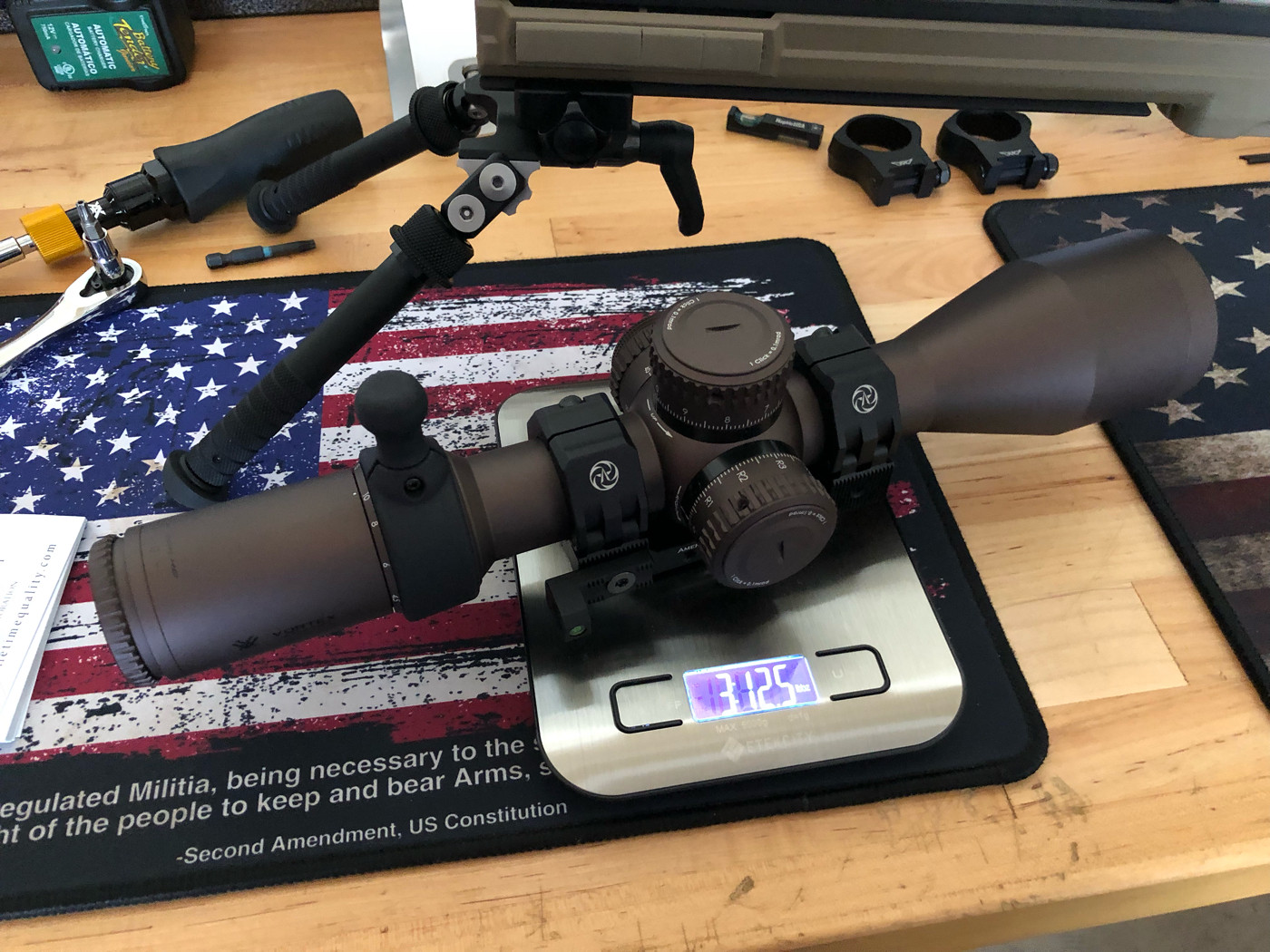
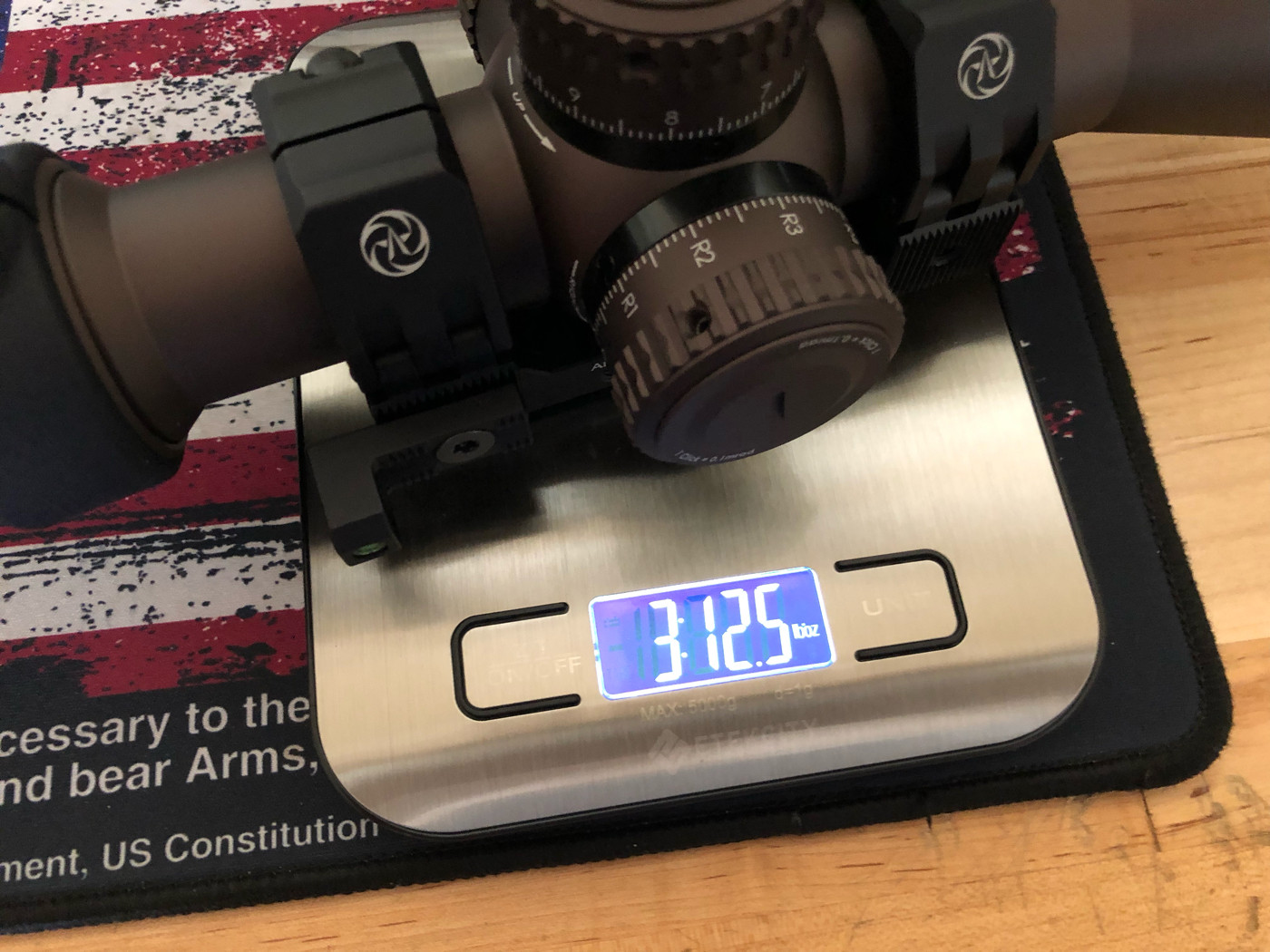


Hey Ted,
Real quick. Are you familiar with Scalarworks LEAP/07 mounts? He uses an ingenious method for scope leveling. I have no idea if it's a patented design, but your center hole in the scope body "bridge" area could certainly do the same / similar idea if enlarged a tad & threaded. I'm just thinking out loud here, as I'd love to see this from you if possible. I DO NOT trust the bubble level on the top turret method, and getting a plumb line setup for me is a PITA. I'm more inline with using the bottom of the scope erector housing leveled out to the scope mount bridge area. Sadly, with my Razor on the 32mm height mount there is no room to use my go-to tool from Arisaka
Again, I'm just throwing out an idea. There's also the "slot" on the side of the bridge area that Spuhr uses. I've never owned one of these, but I'd assume they use a triangulated device similar to Arisaka for leveling.
Thank you for all you do brother, I feel your offering is as much artwork as other's I've owned. And that says a lot, I'm a SUPER picky retired data center engineer.
Thanks a bunch,
Jim
Edit: Well, If I'd read & pay attention I'd be dangerous. Scalarworks states right on the referenced page "patented design" for the level drive. Bummer...
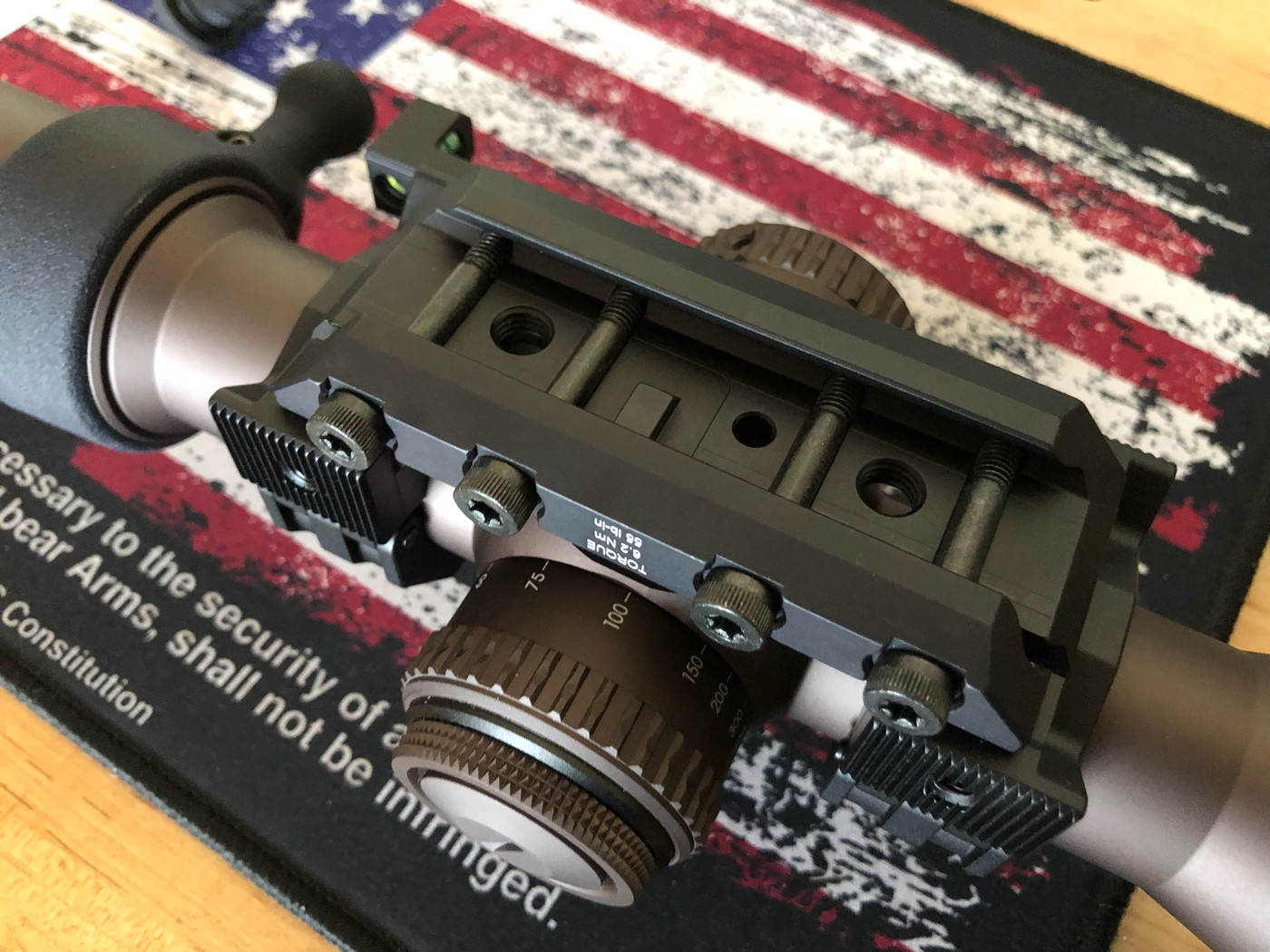
Real quick. Are you familiar with Scalarworks LEAP/07 mounts? He uses an ingenious method for scope leveling. I have no idea if it's a patented design, but your center hole in the scope body "bridge" area could certainly do the same / similar idea if enlarged a tad & threaded. I'm just thinking out loud here, as I'd love to see this from you if possible. I DO NOT trust the bubble level on the top turret method, and getting a plumb line setup for me is a PITA. I'm more inline with using the bottom of the scope erector housing leveled out to the scope mount bridge area. Sadly, with my Razor on the 32mm height mount there is no room to use my go-to tool from Arisaka
Again, I'm just throwing out an idea. There's also the "slot" on the side of the bridge area that Spuhr uses. I've never owned one of these, but I'd assume they use a triangulated device similar to Arisaka for leveling.
Thank you for all you do brother, I feel your offering is as much artwork as other's I've owned. And that says a lot, I'm a SUPER picky retired data center engineer.
Thanks a bunch,
Jim
Edit: Well, If I'd read & pay attention I'd be dangerous. Scalarworks states right on the referenced page "patented design" for the level drive. Bummer...

They patented a screw? Patent pending or granted...do you know?Scalarworks states right on the referenced page "patented design" for the level drive.
Truly have no idea. Maybe just the whole leveling screw idea... but it works REALLY WELL, that I know for a fact.They patented a screw? Patent pending or granted...do you know?
you're assuming every reticle is perfectly square with the housing thoughTruly have no idea. Maybe just the whole leveling screw idea... but it works REALLY WELL, that I know for a fact.
Point well taken, but they should be. Again, you're right.. but I'd still like to see this happen with ARC if possible.you're assuming every reticle is perfectly square with the housing though
My issue with the LEAP, Arisaka, and Spuhr leveling is that all of them put a pretty serious compression onto the bottom of the scope as rings are tightened. Initial leveling, fine, but if the rings also rotate the scope after you remove the tool you’re SOL, and if you leave the tool in it can literally become embedded into the turret base - ask me how I know - and the rings loosen up when the tool is removed with a sledgehammer if you torque everything first.
Plumb bobs are annoying, but that plus ARC rings is the best thing I’ve found that I can do in an apartment.
Plumb bobs are annoying, but that plus ARC rings is the best thing I’ve found that I can do in an apartment.
I wouldn't be too concerned with the position of the scope within the rings. As I have previously mentioned, if you're going to shoot using a level, do the work to ensure that the the vertical crosshair is parallel to a plumb line when the level indicates level.Hey Ted,
Real quick. Are you familiar with Scalarworks LEAP/07 mounts? He uses an ingenious method for scope leveling. I have no idea if it's a patented design, but your center hole in the scope body "bridge" area could certainly do the same / similar idea if enlarged a tad & threaded. I'm just thinking out loud here, as I'd love to see this from you if possible. I DO NOT trust the bubble level on the top turret method, and getting a plumb line setup for me is a PITA. I'm more inline with using the bottom of the scope erector housing leveled out to the scope mount bridge area. Sadly, with my Razor on the 32mm height mount there is no room to use my go-to tool from Arisaka
Again, I'm just throwing out an idea. There's also the "slot" on the side of the bridge area that Spuhr uses. I've never owned one of these, but I'd assume they use a triangulated device similar to Arisaka for leveling.
Thank you for all you do brother, I feel your offering is as much artwork as other's I've owned. And that says a lot, I'm a SUPER picky retired data center engineer.
Thanks a bunch,
Jim
Edit: Well, If I'd read & pay attention I'd be dangerous. Scalarworks states right on the referenced page "patented design" for the level drive. Bummer...

But if you're OCD about it, then I would suggest using the Arisaka device that you referenced, which is nothing more than an adjustable parallel. An adjustable parallel is a simple device that has been around for a really long time and is therefore a good thing. Feels like a Lindy Effect thing to me.
Regarding the use of a screw at the six o'clock position, I think it's ineffective. The screw needs to impart a rolling moment to the scope tube. This is best done if the screw axis does not pass through the center of the scope axis. The leveling screw axis of the Scalarworks mount passes through the scope tube axis. That's bad, unless the screw is very large in diameter and thus able to apply rolling forces off-center by way of its periphery. Pushing the scope at 6 o'clock is kind of like trying to drive a bicycle wheel by passing the chain though the axel rather than by wrapping it around a sprocket. That said, even if there were two screws, each working to roll the scope in opposite directions, it would still be a shitty solution. How will you know when the scope is where you want it?
Spuhr's solution using a wedge (adjustable parallel) is a much better idea. I think it actually works but you must take care not to roll the scope in the rings when tightening a multitude of rings screws. It would work even better in the M-BRACE because our ring design doesn't roll the scope. I would incorporate it but I have too much respect for Hakan to knock off any part of his design, patent or no-patent. I've met him at Shot Show a couple of times and he's a good dude. Not only that, one can either use an adjustable parallel (Arisaka) or one can easily sight though the 12 o'clock ring gap of the M-BRACE and line it up with the index mark of the scope's elevation turret.
But at the end of the day, vertical crosshair parallel to a plumb line when the level indicates level is really what matters most. The rifle can be anywhere. History is full of competitive silhouette shooters that shot obviously canted rifles.
By this time, I really hope it's clear to everyone that American Rifle Company makes the best rings, and now, the best mount as well. Just saying, or bragging...
Ted
Well said sir. Thank you. It always means more coming from a customer.My issue with the LEAP, Arisaka, and Spuhr leveling is that all of them put a pretty serious compression onto the bottom of the scope as rings are tightened. Initial leveling, fine, but if the rings also rotate the scope after you remove the tool you’re SOL, and if you leave the tool in it can literally become embedded into the turret base - ask me how I know - and the rings loosen up when the tool is removed with a sledgehammer if you torque everything first.
Plumb bobs are annoying, but that plus ARC rings is the best thing I’ve found that I can do in an apartment.
Ted
Plumb line it is. I've already got it fairly straight now using the scopes turret index via the rear ring gap.. Thanks for all the responses.
Last edited:
Is the 55 lbf-in dry or with a lubricant? Thanks!You guys are keeping me busy.
Regarding 55 inch-pound torque for scope ring clamp screws.
Our M10 Rings and M-BRACE mount both use a single M5 x 0.8 screw for each scope ring. In order to get approximately the same amount of screw tension (scope clamping force needed to resist recoil) as one would get by applying about 15-20 in-lbs of torque to two smaller screws commonly used on other rings and mounts, 55 in-lbs is must be applied to the M5 screws that we use. Big screws can ultimately carry higher loads, as our single M5 carries about the same load as two smaller screws, but more torque must be applied to do so.
But in the case of your 10/22 (which looks sweet by they way) 55 in-lbs is not required. You'd likely be fine at 30.
How tight should the screws be? Ideally just tight enough to immobilize the scope against recoil forces. How tight is that? It depends on the weight of the scope, the wall thickness of the scope tube, the weight of the rifle, the bore diameter, max chamber pressure, mass moment of inertia of the entire weapon system, etc...
You get the idea. 55 in-lbs is the easy answer.
Oh, and I know, when referring to screw torque, it's proper to express torque as pound-inches instead of inch-pounds. But I like saying inch-pounds, just because. I really like saying Newton-meters because using pounds and inches is really stupid, but such is the world as I find it.
Ted
Small amount of anti seize or oil on the threads and under the bolt heads per ring assembly instructions here (which presumably wouldn’t change for the M-BRACE):Is the 55 lbf-in dry or with a lubricant? Thanks!
I recommend nickel antiseize for literally anything in firearms that doesn’t get loctite.
Whenever inserting steel screws into anodized aluminum thread, I always recommend a lubricant. As Gnochi indicated in the previous post, anti-seize is an excellent choice. If you don't lubricate the threads and the underside of the screw head, fasteners can be really tough to remove, and that might be OK if that's what you want. After all, screws are meant to hold tight.Is the 55 lbf-in dry or with a lubricant? Thanks!
Ted
That is a lesson I have been learning. I think, now, when I get to 15 lbs I remove the Arisaka. No turret customization yet...My issue with the LEAP, Arisaka, and Spuhr leveling is that all of them put a pretty serious compression onto the bottom of the scope as rings are tightened. Initial leveling, fine, but if the rings also rotate the scope after you remove the tool you’re SOL, and if you leave the tool in it can literally become embedded into the turret base - ask me how I know - and the rings loosen up when the tool is removed with a sledgehammer if you torque everything first.
First match with the m-brace. Was using m10 rings before. Went with the mount due to simplicity and to get 1.5”. I like to keep my head as vertical as possible.


Last edited:
- Jan 29, 2018
- 941
- 509
Excellent job. Congratulations and thanks for the business and the post.First match with the m-brace. Was using m10 rings before. Went with the mount due to simplicity and to get 1.5”. I like to keep my head as vertical as possible.
View attachment 7720090
View attachment 7720079
Ted
Going to depend on your scope, eye relief, and length of pull situation. I have one setup where I could probably use the M BRACE and several more where I couldn’t.Anyone try this mount on a small frame AR? Is there enough cantilever to make it work?
Anyone try this mount on a small frame AR? Is there enough cantilever to make it work?
NTCH and you are probably hosed on most scopes. I am really intrigued by the mount, but at this point, its dicey for the scopes I run on my ARs.
Similar threads
- Replies
- 6
- Views
- 372
- Replies
- 0
- Views
- 140
- Replies
- 9
- Views
- 683
- Replies
- 68
- Views
- 6K
- Replies
- 2
- Views
- 332
